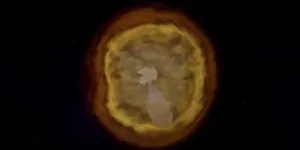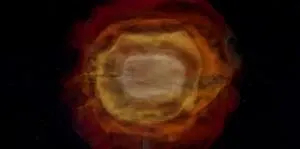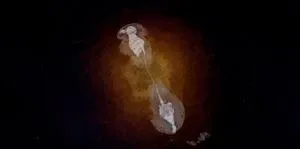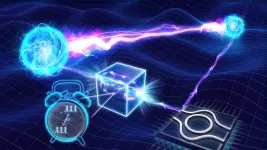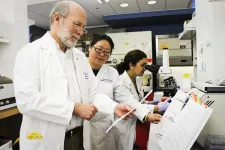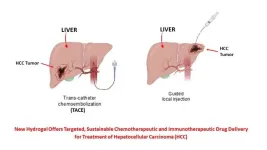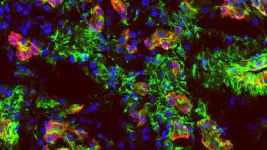(Press-News.org) Cutting-edge computer simulations combined with theoretical calculations are helping astronomers better understand the origin of some of the universe’s most energetic and mysterious light shows — gamma-ray bursts, or GRBs. The new unified model confirms that some long-lasting GRBs are created in the aftermath of cosmic mergers that spawn an infant black hole surrounded by a giant disk of natal material.
Astronomers previously thought that black holes that generate long GRBs typically form when massive stars collapse. However, the new model shows that they can also arise when two dense objects merge, such as a pair of neutron stars — the dense, dead remnants of massive stars — or a black hole and a neutron star. The findings explain recently observed long GRBs that astronomers couldn’t link to collapsing stars.
The simulation’s creators present their results November 29 in The Astrophysical Journal Letters.
“Our findings, which connect observations with underlying physics, have unified many unresolved mysteries in the field of gamma-ray bursts,” says Ore Gottlieb, lead author on the new study and a research fellow at the Flatiron Institute’s Center for Computational Astrophysics (CCA) in New York City. “For the first time, we can look at GRB observations and know what happened before the black hole formed.”
GRBs are some of the brightest and most violent events in the cosmos. Since their first detection in 1967, GRBs have dazzled and puzzled astronomers. Even decades later, the exact mechanisms that generate the powerful blasts of gamma rays remain uncertain. Over the years, astronomers have noticed two distinct populations of GRBs — ones lasting less than a second and others that linger for 10 seconds or more. Researchers eventually determined that short GRBs originate from jets launched after the merger of two compact objects and that long GRBs can occur when jets are launched during the collapse of massive rotating stars. But in the past year, two unusual long GRB observations suggested that collapsing behemoths weren’t the only things causing long GRBs.
Gottlieb and his colleagues ran state-of-the-art simulations to test how mergers of massive compact objects can spark GRBs. The new simulations took months to run and were conducted in part on one of the Flatiron Institute’s supercomputers. The new simulations start when the two compact objects are in a close orbit and follow the jets until they are far from the merger site. This approach allows the researchers to make fewer assumptions about the physics involved. By combining the simulations with constraints from astronomical data, the scientists constructed a unified model for the GRB origins.
The researchers determined that the unusual GRBs are generated in the aftermath of a merger between two compact objects. After merging, the objects create a black hole surrounded by a large accretion disk — a rapidly-rotating doughnut of magnetically charged leftover material — that can pump out long GRBs. This information from the simulation helps astronomers understand not only the objects creating these GRBs but also what came before them.
“If we see a long GRB like the ones observed in 2022, we now know that it’s coming from a black hole with a massive disk,” Gottlieb says. “And knowing there is a massive disk, we now can figure out the ratio of the masses of the two parental objects because their mass ratio is related to the properties of the disk. For example, the merger of unequal-mass neutron stars will inevitably produce a long-duration GRB.”
The scientists hope to use the unified model to identify what objects create short GRBs. Those bursts, the model suggests, could be caused by black holes with smaller accretion disks, or they might come from an object called a hypermassive neutron star, which is an unstable form of the star that quickly collapses to form a black hole, but not before it pulses out short GRBs. The scientists hope that with more observations of GRBs, they can further refine their simulation to determine all GRB origins. Though GRB sightings remain relatively rare, astronomers aim to capture many more when the Vera C. Rubin Observatory starts observing in early 2025.
“As we get more observations of GRBs at different pulse durations, we’ll be better able to probe the central engines powering these extreme events,” Gottlieb says.
ABOUT THE FLATIRON INSTITUTE
The Flatiron Institute is the research division of the Simons Foundation. The institute's mission is to advance scientific research through computational methods, including data analysis, theory, modeling and simulation. The institute's Center for Computational Astrophysics creates new computational frameworks that allow scientists to analyze big astronomical datasets and to understand complex, multi-scale physics in a cosmological context.
END
New astrophysics model sheds light on additional source of long gamma-ray bursts
Using state-of-the-art computer simulations, astrophysicists at the Flatiron Institute and their colleagues have sharpened our picture of how black holes may generate some of the universe’s most energetic outbursts
2023-11-29
ELSE PRESS RELEASES FROM THIS DATE:
Brain scans of former NFL athletes show a repair protein in place long after initial injury
2023-11-29
FOR IMMEDIATE RELEASE
In a new study using brain scans of former NFL athletes, Johns Hopkins Medicine researchers say they found high levels of a repair protein present long after a traumatic brain injury such as a concussion takes place. The repair protein, known as 18 kDa translocator protein (TSPO), is known to be present in the brain at high levels in the immediate aftermath of brain injury as part of the inflammatory response and to facilitate repair. The new findings, published Oct. 30 in JAMA Network Open, suggest that brain injury and repair processes persist for years after players end collision sports careers, and lead to long-term cognitive ...
Long-live quantum entanglement goes to distance
2023-11-29
Quantum technologies are currently maturing at a breath-taking pace. These technologies exploit principles of quantum mechanics in suitably engineered systems, with bright prospects such as boosting computational efficiencies or communication security well beyond what is possible with devices based on today’s 'classical' technologies. As with classical devices, however, to realise their full potential, quantum devices will need to be networked. In principle, this can be done using the fibre-optic networks employed for classical telecommunications. But practical implementation requires that the information ...
To build better tuberculosis vaccines, Saint Louis University researchers develop a new model by leveraging an old vaccine
2023-11-29
ST. LOUIS – Each year, tuberculosis (TB) kills more people than any other infectious disease, falling out of the top spot only temporarily during the COVID-19 pandemic.
Despite TB’s wide reach and some lost progress during the COVID-19 pandemic, researchers believe it is possible to eradicate TB through advances in vaccine development and public health. To cross the finish line, scientists must find ways to test new vaccines rapidly to prevent TB infections more effectively.
In a paper published in the Journal of Infectious Diseases, Daniel Hoft, M.D., Ph.D., ...
Improving our understanding of the effects of PFOS on fish
2023-11-29
Two papers recently published in Environmental Toxicology and Chemistry have made important advancements toward understanding the effects of perfluorooctane sulfonate (PFOS) on aquatic life, especially fish. Zebrafish had been identified in a previous study of limited scope as being among one of the most sensitive aquatic species to PFOS, and the results of that limited-scope study have influenced PFOS water quality criteria derived by some regulatory agencies, including the Australian Environmental Protection Agency (EPA).
Kurt Gust and ...
Enhanced treatment of liver carcinoma with a drug-eluting hydrogel
2023-11-29
(LOS ANGELES) – November 29, 2023 - Scientists from the Terasaki Institute for Biomedical Innovation (TIBI) have developed an injectable or catheter-administered hydrogel with enhanced capabilities for treating hepatocellular carcinoma (HCC), a deadly form of liver cancer. As described in their recent publication in Advanced Functional Materials, this drug-eluting hydrogel can provide sustained, pH-dependent drug co-delivery and has capabilities for promoting anti-tumor immune responses. This reduces tumor cell proliferation and growth and offers a more efficient means of enabling tumor cell death.
Worldwide, HCC is a leading cause of ...
Applying semiconductor manufacturing principles to optoelectronic devices
2023-11-29
Optoelectronics detect or emit light and are used in a variety of devices in many different industries. These devices have historically relied on thin transistors, which are small semiconductors that control the movement of electrons and photons, made out of graphene and other two-dimensional materials. However, graphene and these other materials often have problems with band gap opening and other shortcomings that have researchers searching for an alternative.
When treated with a method called the ...
The role of marketing in disrupted health care markets: It’s time to move beyond conventional strategies to account for new actors, roles, and exchanges
2023-11-29
Researchers from Duke University, University of New South Wales, University of Wisconsin, and University of Washington published an editorial for the Journal of Marketing that calls for marketing to tackle the challenges and opportunities in dynamic contemporary health care markets.
The editorial, introducing a special issue on “Marketing in the Health Care Sector” for the Journal of Marketing, is titled “Marketing in the Health Care Sector: Disrupted Exchanges and New Research Directions” and is authored by Christine Moorman, Harald J. van Heerde, C. Page Moreau, and Robert W. Palmatier. The special issue ...
Can we crack this cancer’s immune response?
2023-11-29
Recent findings at Cold Spring Harbor Laboratory (CSHL) shine a new light on pancreatic cancer.
More than 90% of pancreatic cancer cases are attributed to an aggressive, deadly form of the disease called pancreatic ductal adenocarcinoma, or PDAC. Researchers have a poor understanding of how our immune system interacts with PDAC. So, coming up with treatments is tricky. It’s thought patients do not show a natural immune response to the cancer because the tumor environment somehow prevents that response. Many are unconvinced that PDAC ...
Building blocks for life could have formed near new stars and planets
2023-11-29
While life on Earth is relatively new, geologically speaking, the ingredients that combined to form it might be much older than once thought. According to research published in ACS Central Science, the simplest amino acid, carbamic acid, could have formed alongside stars or planets within interstellar ices. The findings could be used to train deep space instruments like the James Webb Space Telescope to search for prebiotic molecules in distant, star-forming regions of the universe.
It has long been hypothesized that one of the building blocks for life, amino acids, could have formed during reactions in the “primordial ...
Uttam Superrhiza named as winner of Applied Microbiology International Product of the Year 2023
2023-11-29
Mycorrhiza biofertilizer Uttam Superrhiza has been named as the winner of the Applied Microbiology International Product of the Year 2023.
The prestigious prize recognizes a commercial product derived from microbiology research, with special consideration given to those products that have addressed the United Nations Sustainable Development Goals.
Uttam Superrhiza, marketed by Chambal Fertilizers and Chemicals Limited in India, is manufactured by the not-for-profit institute, The Energy and Resources Institute (TERI).
Disruptive mycorrhiza
A disruptive ...
LAST 30 PRESS RELEASES:
Can community awareness campaigns in low-resource areas improve early diagnosis of colorectal cancer?
Stardust study resets how life’s atoms spread through space
Practical education: Clinical scenario-based program development
The impact of family dynamics on eating behaviour – how going home for Christmas can change how you eat
Tracing the quick synthesis of an industrially important catalyst
New software sheds light on cancer’s hidden genetic networks
UT Health San Antonio awarded $3 million in CPRIT grants to bolster cancer research and prevention efforts in South Texas
Third symposium spotlights global challenge of new contaminants in China’s fight against pollution
From straw to soil harmony: International team reveals how biochar supercharges carbon-smart farming
Myeloma: How AI is redrawing the map of cancer care
Manhattan E. Charurat, Ph.D., MHS invested as the Homer and Martha Gudelsky Distinguished Professor in Medicine at the University of Maryland School of Medicine
Insilico Medicine’s Pharma.AI Q4 Winter Launch Recap: Revolutionizing drug discovery with cutting-edge AI innovations, accelerating the path to pharmaceutical superintelligence
Nanoplastics have diet-dependent impacts on digestive system health
Brain neuron death occurs throughout life and increases with age, a natural human protein drug may halt neuron death in Alzheimer’s disease
SPIE and CLP announce the recipients of the 2025 Advanced Photonics Young Innovator Award
Lessons from the Caldor Fire’s Christmas Valley ‘Miracle’
Ant societies rose by trading individual protection for collective power
Research reveals how ancient viral DNA shapes early embryonic development
A molecular gatekeeper that controls protein synthesis
New ‘cloaking device’ concept to shield sensitive tech from magnetic fields
Researchers show impact of mountain building and climate change on alpine biodiversity
Study models the transition from Neanderthals to modern humans in Europe
University of Phoenix College of Doctoral Studies releases white paper on AI-driven skilling to reduce burnout and restore worker autonomy
AIs fail at the game of visual “telephone”
The levers for a sustainable food system
Potential changes in US homelessness by ending federal support for housing first programs
Vulnerability of large language models to prompt injection when providing medical advice
Researchers develop new system for high-energy-density, long-life, multi-electron transfer bromine-based flow batteries
Ending federal support for housing first programs could increase U.S. homelessness by 5% in one year, new JAMA study finds
New research uncovers molecular ‘safety switch’ shielding cancers from immune attack
[Press-News.org] New astrophysics model sheds light on additional source of long gamma-ray burstsUsing state-of-the-art computer simulations, astrophysicists at the Flatiron Institute and their colleagues have sharpened our picture of how black holes may generate some of the universe’s most energetic outbursts
